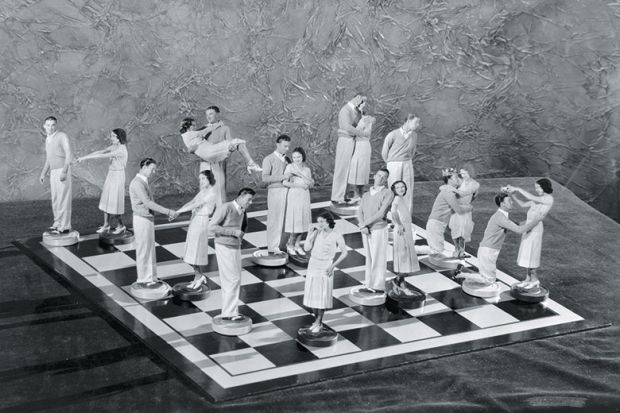The “seduction community” – the world of pick-up artists – is awash with terms straining to announce their importance. There is “kino” (physical contact); the “approach” and “approach anxiety’’; “sets” and “sarges” and “LMR” (last-minute resistance) – an entire compendium of insider terminology designed to insist that there is precise, technical knowledge at work.
The seduction community is an informal yet remarkably organised network of men teaching and learning the art of seducing women. In workshops, books, internet forums and in-field training in bars and clubs, its procedural jargon makes complex, unpredictable and anxiety-provoking human interactions appear as if subject to rules, as systems in which predictable inputs deterministically yield outputs. The Daygame Blueprint, for instance, is: Capture, Attraction, Rapport, Seduction.
It’s easy to laugh, and to recoil in horror. Rachel O’Neill’s compelling book offers an immersion in and dissection of this world, through intensive observation and in-depth interviews. She places seduction in a larger context, one where neoliberal values of the market – entrepreneurship, and the constant improvement of the branded self – are fully absorbed in intimate life, and one infused with the post-feminist claim that feminism has achieved its aims and need no longer trouble us with its fun-spoiling injunctions on sexual politics.
Throughout, O’Neill outlines the competitive individualism and the work ethic that now inhabit our understanding of our intimate lives. The seduction community is not a departure from other contemporary sexual, romantic and professional norms, but precisely an extension of them. Seduction, as a set of techniques, an apprenticeship that, if rigorously followed, will inevitably yield results, is appealing to men because of its promise of control. Men learn how to wield or regain control, and how to display that control to other men. A work ethic suffuses their professional and sexual lives equally (many interviewees comment on seduction’s unintended professional benefits) because both are crucial to a perceived successful masculinity.
This disciplined devotion to sexual success is, however, curiously joyless. The act of seducing women, writes O’Neill, “has become entirely dissociated from any kind of embodied desire for sex or intimacy”. Many interviewees evoke, despite themselves, fatigue and melancholia about their dogged pursuit of sex: “I was getting bored of sex,” says one. They become alienated from the potential pleasures of sexual experience. The ever-receding horizon of success and an always prospective relationship to happiness create a melancholic avoidance of desire, longing or joy. The intricately rehearsed spontaneity of “approaches” and a rule-bound conception of human interaction have their costs.
Aside from sex, what men gain from this community is bittersweet: a potentially different model of male friendship. Several scholars have emphasised the centrality of ridicule and humiliation to heterosexual male homosociality, in which heterosexuality must be continually reinforced, and men compete for its sought-after resource (sex). The fraternity offered in seduction is utilitarian, characterised by strategic relations and the enforcement of norms (of behaviour, of style and so on), but it is nonetheless a fraternity, in which men enable rather than sabotage one another’s sexual encounters, and offer encouragement and constructive feedback.
Yet these relations are highly commodified and are governed by capital. This is a market-based intimacy between heterosexual men – one that, as O’Neill briefly notes, is a platonic parallel to the phenomenon of “professional girlfriends”. One interviewee says of his mentor: “He sees me more as a client, which is fine. I see him as a friend, but we keep it professional.” This “professional friendship” speaks of the bind of male friendship: men are required to demonstrate their heterosexual competence to other men, and yet are prevented from asking for help from those who appear to possess that competence. The seduction community offers a structured way out, and in the pages of this book something powerfully mournful emerges about the constraints placed on heterosexual male friendship.
O’Neill aims to refrain from characterising the men in the seduction community as “pathetic, pathologic, or perverse”. The material she uncovers, however, clearly indicates the pathologies that it reinforces. The most salient example is the phenomenon of “in-field videos”, in which interactions with women, who do not know that they are being filmed with hidden devices, are used for training purposes. This voyeurism, and this overriding neglect of consent, is crucial; displays before an audience serve in particular to emphasise, I think, men’s control and access to women, and their ability to dispense cruelty and humiliation.
Prevalent in the seduction community is an insistence that women control access to sex, and hence have great power; men frame themselves as powerless, hence the elaborate technical means (seduction) to redress this power imbalance. But the flagrant violations of consent and privacy involved in their tactics suggest also an urge to punish women they see as “high value” and in control of the resource they want access to. The salience of this rhetoric in recent conversations about “involuntary celibates” and male violence bolsters O’Neill’s claim that the logic underpinning seduction is not insulated from a wider culture in which coercion and violence towards women are normalised and rationalised.
Crucial, too, to the logic of seduction is an attachment to evolutionary psychology, and a resurgent biologism that enables men to insist on “reading” the female body as up-for-it, disregarding what a woman is saying about her sexual desire. A pseudo-feminist rhetoric invokes the strength of female sexual desire and the silencing power of the sexual double standard in order to ground men’s right (duty, even) to push women into sex; women want sex, but are too ashamed and reputation-anxious to say so; hence the need for tactics to overcome “last-minute resistance”.
Much of this makes for unsettling reading, and the research was clearly taxing. Listening to men say “you have to disregard what the girl says and be self-assured” could not have been easy, and O’Neill writes in a fascinating postscript about the methodological and ethical challenges of the work, and of feeling taken advantage of, manipulated, humiliated, and having power asserted over her, by her interlocutors. No researcher is neutral – a male interviewer would have elicited a different set of problematic responses (rivalry, competition, humiliation of masculinity) – and the conventions of this kind of text might not have allowed for it, but I would have liked to hear more about how O’Neill’s implication in her research might have affected the interactions she sought to observe. She writes movingly about the sobering dilemmas of feminist research, and about the gendered social conventions constraining women’s agency. The dynamics that her research elicited were, she writes, disconcerting to her as a researcher, but “not unfamiliar to me as a woman”.
O’Neill takes no prisoners in this remarkable book. But nowhere does she lose sight of contextualising the discourse that she scrutinises in relation to larger contexts of injustice and inequality. The men she interviews see themselves as the beleaguered party in a zero-sum game; their feelings of frustrated entitlement are real, although they do not accurately describe their condition. Men, she argues, have been encouraged to understand whatever difficulties they experience (economic, social) in gendered terms. These men are seeking to find power in the context of their intimate lives, rather than questioning the wider social, political and economic arrangements that precipitate profound feelings of disempowerment. O’Neill understands that we all suffer through this arduous, joyless labour of seduction: men, in their loneliness and constraining masculinity, and women, as targets of the coercive instrumentalisation it reinscribes.
Katherine Angel is lecturer in creative and critical writing at Birkbeck, University of London and the author of Unmastered: A Book on Desire, Most Difficult to Tell (2012).
Seduction: Men, Masculinity and Mediated Intimacy
By Rachel O’Neill
Polity, 256pp, £55.00 and £16.99
ISBN 9781509521555 and 9781509521562
Published 25 May 2018
The author
Rachel O’Neill is a postdoctoral research fellow in sociology at the University of York, which she joined in 2016 after completing a PhD in gender and cultural studies at King’s College London.
“I grew up between Canada and Ireland,” she says, “eventually finding my way to study in Galway. My undergraduate degree was broad-ranging, as students were permitted to take four subjects in their first year before later specialising in one or two. Although I had initially planned to study English to degree level, an introductory lecture on the sociology of love put paid to those plans. I was fascinated by the idea that experiences we perceive as deeply personal are in fact socially patterned.”
It was while studying for an MSc at the London School of Economics’ Gender Institute (now the department of gender studies) that O’Neill first became interested in the seduction industry. She has now been following it for almost a decade and the main body of fieldwork on which the book is based lasted over a year.
She recalls a number of challenges: “When attending events, my presence was always conspicuous; I rarely, if ever, faded into the background. This was disconcerting in some ways – I was hypervisible – but also provided opportunities to talk to people about the research I was doing.”
Although “feminist campaigns have targeted individual seduction trainers on the grounds that their teachings are sexist and racist”, O’Neill believes that it is also necessary to take a more sustained political approach and “focus attention on the industry’s core practices – such as the routine filming of women without their consent – in order to challenge its wider workings. Ultimately, it is the twin rationalities of neoliberalism and postfeminism that gave rise to the seduction industry which demand our most trenchant critique and continued attempts at intervention.”
Matthew Reisz
后记
Print headline: For both sexes, a loser’s game




